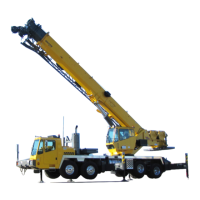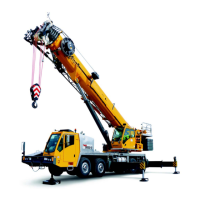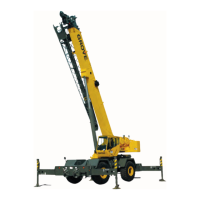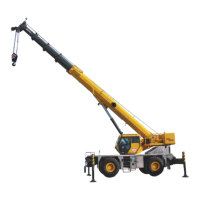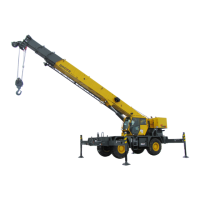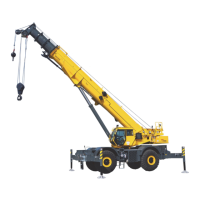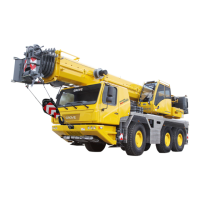2-25
TMS800E SERVICE MANUAL HYDRAULIC SYSTEM
Published 01-29-2014, Control # 496-00
Procedure A - For Checking/Setting the Main
Directional Control Valve for Hoist(s) and
Boom Lift
Set hoist(s) boom lift and telescope inner mid retract as
follows:
1. Install pressure check diagnostic quick disconnect with
gauge onto test nipple at the GP2 port of the swing and
accessory manifold (see Figure 2-14).
2. Ensure piston pump “P” max (see Figure 2-21) factory
setting is correct. Loosen the jam nut on the “P” max
adjusting screw and turn it “in” until it softly seats or
bottoms out. Then back the adjusting screw “out” 1/4 to
1/2 turn and lock in place with jam nut. This will ensure
that full system pressure of 276 bar (4000 psi) can be
obtained in step # 4.
3. If the lift cylinder is not installed, plug the extend hose
(the larger of the two). If lift cylinder is installed, omit this
step and continue to step 4.
4. Start engine and throttle up to full RPM. Feather into the
boom lift controller to full controller stroke (Up or down)
and hold. If the boom is installed, boom up to max
elevation and hold or boom down to minimum elevation
and hold. Adjust the load sense relief valve “in” to
increase or “out” to decrease so that a gauge pressure
reading of 276 +
4 bar (4000 ± 50 psi) is achieved (see
Figure 2-15).
5. Stop engine and remove the diagnostic couplers from
the test nipples.
Set the telescope extend and retract as follows:
Extend
6. If the boom is not installed, install a pressure check
diagnostic quick disconnect with gauge onto test nipple
at the GP5 port at the inlet of the main directional control
valve (see Figure 2-15).
7. Cap hose (the larger of the two) running from port A,
telescope section of the main directional control valve to
the cylinder port block at the back of the base section.
8. Start engine and throttle up to full RPM. Attempt to
extend boom by feathering into the controller to full
controller stroke. Adjust the work port relief valve “in” to
increase or “out” to decrease so that a gauge pressure
reading of 179 +
4 bar (2600 ± 50 psi) is achieved (see
Figure 2-15).
9. If the boom is installed, start engine and throttle up to full
RPM. Fully extend the boom and hold. Adjust the work
port relief valve “in” to increase or “out” to decrease so
that a gauge pressure reading of 179 +
4 bar (2600 ± 50
psi) is achieved (see Figure 2-15)
10. Stop engine and remove pressure gauge and re-connect
plumbing.
Retract
11. If the boom is not installed, install a pressure check
diagnostic quick disconnect with gauge onto test nipple
GP5 at the inlet of the main directional control valve (see
Figure 2-15).
12. Cap hose (the smaller of the two) running from port B,
telescope section of the main directional control valve to
the cylinder port block at the back of the base section.
13. Start engine and throttle up to full RPM. Attempt to
retract boom by feathering into the controller to full
controller stroke. Adjust the work port relief valve “in” to
increase or “out” to decrease so that a gauge pressure
reading of 239 +
4 bar (3460 ± 50 psi) is achieved (see
Figure 2-15).
14. If the boom is installed, start engine and throttle up to full
RPM. Fully retract the boom and hold. Adjust the work
port relief valve “in” to increase or “out” to decrease so
that a gauge pressure reading of 239 +
4 bar (3460 ± 50
psi) is achieved (see Figure 2-15).
15. Stop engine and remove pressure gauge and re-connect
plumbing.
Set the cab tilt and counterweight removal pressure as
follows:
16. Install pressure check diagnostic quick disconnect with
gauge onto test nipple at the GP2 port of the swing and
accessory manifold (see Figure 2-14).
Pump Differential Pressure Setting (ISX
Engine)
26
(375)
± 4 (50) GP2 Carrier mounted piston pump
(see Figure 2-21)
Center Front Stabilizer Relief Setting 10 - 20
(150 - 300)
Not Adjustable GP Carrier mounted in Outrigger 5
stack valve (see Figure 2-22)
Pump Differential Pressure Setting (GSM
Engine)
26-29
(375-425)
See Range GP2 Carrier mounted piston pump
(see Figure 2-21)
Valve To Be Set
Pressure
Setting
bar (PSI)
Tolerance
bar (PSI)
Gauge Port (GPX) and Adjustment
Location
Reference Only

